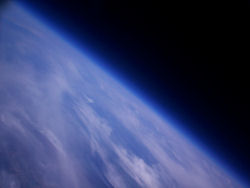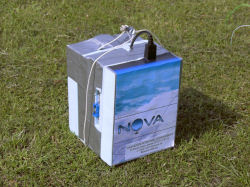A group of ambitious students from the Department have set themselves a sky-high goal – to launch a rocket into space for under £1000.
This marks the first step in a series of flights to prove our tracking and telemetry systems.
Carl Morland



The first component of the system has just been tested, producing spectacular images of the curvature of the Earth from the upper atmosphere.
The team used a high altitude helium balloon to launch their tiny payload, no bigger than a lunchbox. Packed with instrumentation, it flew to nearly four times the height of Everest before descending by parachute, taking photographs throughout the flight.
“This marks the first step in a series of flights to prove our tracking and telemetry systems. Once we can take a larger payload stably up to 30km, we will be in a position to launch a rocket from the balloon that will reach the 100 kilometre boundary of space for a tiny fraction of the present cost,” says Carl Morland, founder of the project. “By using a balloon to go as high as possible, a considerably smaller rocket can be used as there is much less drag due to the thinner air.”
Project Nova is part of Cambridge University Spaceflight, a student-run organisation dedicated to space flight development. The balloon carried a camera, a data transmission system and two tracking systems, as well as the parachute. “We can track its position to within ten metres”, says Henry Hallam, responsible for developing the tracking system. Robert Fryers, whose work on miniaturising the electronics was vital in making the flight possible, is excited about the future possibilities. “By reducing the size and weight of our control systems like this, we can go higher and carry more experiments.”
The flight lasted about three hours, producing over 800 images. “After a tense night of checks, we took the balloon and payload to the launch site at Churchill College, Cambridge,” says Hallam. The balloon was filled with enough helium to lift the payload at a steady rate of ascent of about 11mph. As the balloon rises it expands and it will keep on rising until it bursts, which it did exactly two hours after lift-off at an altitude of 32.2km or 105,600 ft above sea level. The descent was initially rapid in the thin air, reaching a peak descent rate of 100mph. Once the parachute had fully opened, the balloon landed safely at 12mph.”
Cambridge University Spaceflight's Nova project is supported by the Cambridge-MIT Institute.
A video of the launch and a gallery of some of the photos can be found at www.cuspaceflight.co.uk. Further launches are planned for the coming weeks.
Please note, readers should not attempt similar experiments without the support of professional engineers, a thorough safety assessment, and the consent of the Civil Aviation Authority.

